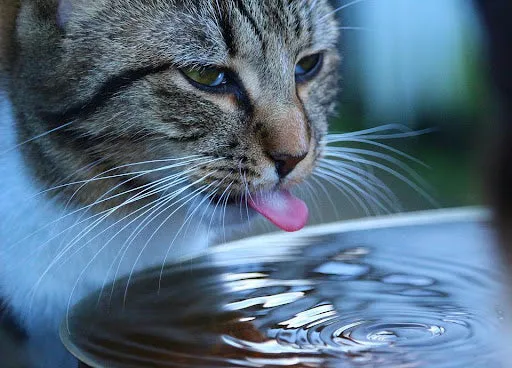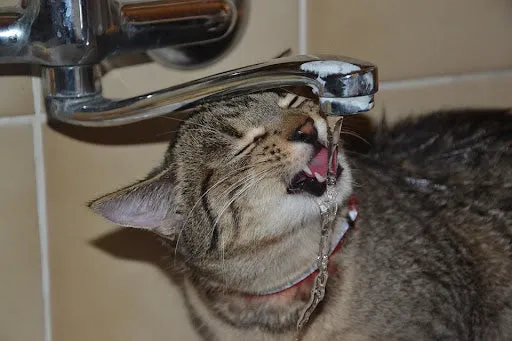Bringing a new kitten into your home is an exciting experience, but it also comes with a unique set of responsibilities. Among the most crucial aspects of their early care is ensuring they stay properly hydrated. You might assume your new feline companion instinctively knows the importance of drinking water, but often, kittens can be quite finicky, making it a challenge for many cat parents to get their little furballs to drink enough water or even eat wet food. Dehydration can lead to numerous serious health complications in a very short time, making it imperative to address a kitten not drinking water promptly. This guide will provide you with all the essential tips on How To Teach A Kitten To Drink Water and keep them happy and healthy.
Understanding Your Kitten’s Water Needs
Hydration is fundamental for the well-being of all mammals, and kittens are no exception. Knowing how much water your kitten should consume daily is the first step. The general recommendation for felines is approximately 50ml of water per kilogram of body weight each day. This intake accounts for their metabolic processes and the moisture they obtain from their food. This guideline helps ensure their bodies function optimally, supporting growth and overall health.
Why Kittens Might Refuse to Drink Water
If your kitten isn’t making regular trips to the water bowl, it’s essential to understand the potential reasons behind their reluctance. Kittens can be surprisingly particular about their drinking habits.
There are several common factors that could be deterring your feline friend from drinking enough water:
- Bowl Accessibility: If your kitten has difficulty reaching the water bowl, they might not bother. Young kittens, especially, need easy access. Place their bowl in an easily accessible spot where they don’t have to navigate obstacles or climb to reach it.
- Water Cleanliness: Just like humans, felines prefer clean, fresh water. Check their bowl regularly for hair, food particles, dust, or other debris. A dirty bowl is a major deterrent. Make it a habit to clean the bowl thoroughly and replace the water at least once a day, ideally more frequently, to ensure it’s always sparkling fresh.
- Location: Kittens can be quite high-maintenance when it comes to the placement of their resources. They might not appreciate the location of their water bowl. Try moving it away from their food bowl, as some cats dislike drinking right next to where they eat. Additionally, never place the water bowl near their litter tray, as cats are naturally averse to consuming water near their waste area. Experimenting with different locations might do the trick.
- Appearance and Material of the Bowl: Your kitten might find their current water bowl unappealing, believe it or not! Some cats are finicky about the material or shape of their drinking vessel. Offer a variety of water bowls made from different materials—such as glass, ceramic, stainless steel, or even plastic (though some cats dislike plastic due to potential odors or taste)—to discover which one your kitty prefers.
Practical Strategies to Encourage Your Kitten to Drink
Once you’ve identified potential reasons for your kitten’s reluctance, you can implement several effective strategies to encourage them to drink more. These methods capitalize on a cat’s natural instincts and preferences.
Provide Multiple Water Stations
Your kitten’s water sources, along with their litter trays, should always be easily at hand. If you live in a multi-level home, ensure you have an easily accessible water bowl on each floor. Kittens are unlikely to make an extra effort to seek out a bowl far from their current location. Strategically place bowls near their favorite resting spots, play areas, and wherever they spend most of their time. This ensures that water is always within sight and easy reach, making them more likely to take a sip throughout the day.
 A small, ginger kitten with a focused expression looking at water in a bowl.
A small, ginger kitten with a focused expression looking at water in a bowl.
Invest in a Cat Water Fountain
Many cats are captivated by running water, a trait that stems from their wild ancestors who instinctively preferred moving water sources, perceiving them as fresher and safer than stagnant pools. Investing in a cat water fountain can be a game-changer. It might take your feline companion a little while to figure out how to use it, but once they do, they often prefer it over a still water bowl. The constant flow keeps the water aerated and fresh, and the novelty of the movement can entice even the most reluctant drinkers. Water fountains also reduce the need for constant refilling, making them convenient for busy pet owners.
Make Tap Water an Enticing Option
Capitalize on your kitten’s fascination with running water by occasionally turning on the faucet. If your kitty is drawn to the tap, it will naturally encourage them to drink more. You can turn this into a fun, interactive game or a part of your daily routine. Run the tap for a few minutes several times a day, allowing your kitten to bat at the stream and drink from it. This activity can also serve as a bonding experience between you and your feline friend. Always offer praise or a small treat when they drink from the tap to reinforce this positive behavior.
 A kitten intently drinking from a ceramic bowl, its tongue just touching the water.
A kitten intently drinking from a ceramic bowl, its tongue just touching the water.
Add Ice Cubes to Their Food
A simple yet effective trick to increase your kitten’s water intake is to add a few ice cubes to their wet food. As the ice melts, it adds extra moisture to their meal and subtly takes on the delicious flavor of their food. Your kitty will likely start licking the ice as it melts, thus ingesting more water without even realizing it. This method is especially useful for kittens who are particularly resistant to drinking from a bowl.
Transition to a Wet Food Diet
If your kitten consistently refuses to drink enough water and is primarily on a dry food diet, making the switch to wet delicacies, or at least incorporating them, is highly recommended. Wet food contains significantly more moisture—typically 70% and up—compared to dry kibble, which usually has around 10% moisture. This high water content in wet food can substantially contribute to your kitten’s daily hydration needs.
Dry cat food, while convenient, often contains a higher percentage of carbohydrates, such as grains and sugars, which are not ideal for a cat’s digestive system. A diet exclusively of dry food can lead to unhealthy eating habits like gorging and overeating, and can make them crave unhealthy human foods. Furthermore, if kittens are fed only biscuits from a young age, they may develop a strong preference and refuse wet food later in life. If your kitten is resistant to giving up dry food entirely, you can try adding water, a little low-sodium chicken broth, or cat-specific soup to their kibble to increase its moisture content.
The Nutritional Benefits of Wet Food for Kittens
Beyond aiding hydration, a high-quality wet food diet provides kittens with essential nutrients crucial for their development. Good wet cat food should be rich in animal protein (more than 50%), contain appropriate levels of animal fat (up to 20%), and be very low in carbohydrates (less than 3%). This nutritional profile closely mimics a cat’s natural diet.
Cats are obligate carnivores, meaning their digestive tracts are designed to process nutrients primarily from animal tissues. Therefore, vegetable proteins cannot replace animal protein in their diet. Feeding a kitten a vegan diet can deprive them of vital micronutrients like taurine and various vitamins, leading to severe health problems. While some vegetable protein sources like peas or carrots can be included in tiny amounts if your kitten requires additional fiber, such instances are rare and should be discussed with a vet. As soon as your kitty is weaned and begins eating solids, their diet should consist of ingredients like shrimp, sardines, cooked chicken, turkey, liver, tuna, mackerel, and salmon. Ham, pork, or bacon can be given occasionally due to their higher fat content. Understanding what, how often, and how much your kitten should eat is crucial for their happiness, health, and hydration during this critical developmental stage.
Recognizing Signs of Dehydration in Kittens
It’s vital for every cat owner to recognize the signs of dehydration, especially in kittens who are more vulnerable. Early detection can prevent serious health issues.
Common symptoms of dehydration in felines include:
- Dry Gums: Healthy gums are moist and pink. If your kitten’s gums feel sticky or dry, it’s a strong indicator of dehydration.
- Sunken Eyes: Dehydrated kittens may have noticeably sunken eyes due to fluid loss.
- Loss of Appetite: A decrease or complete loss of appetite can also be a symptom of dehydration.
- Intense Vocalization: While kittens vocalize for many reasons, excessive or unusual meowing might indicate discomfort, including dehydration.
- Reduced Skin Elasticity: Gently pinch the skin on your kitten’s scruff. If it takes a long time to return to its normal position, it suggests dehydration.
If you observe any of these symptoms or are generally concerned about your kitten’s hydration levels, especially if they are not using the litter box regularly despite being litter-trained, it’s crucial to contact your veterinarian immediately. Not drinking enough water can lead to severe health problems such as urinary tract infections, kidney issues, diabetes, and heart disease. Regular monitoring of your kitten’s water intake and overall behavior is key to maintaining their health and well-being.
Conclusion
Ensuring your kitten stays properly hydrated is a fundamental aspect of responsible pet care. While kittens can sometimes be particular about their water intake, understanding their needs and implementing practical strategies can make a significant difference. From providing multiple clean water bowls and investing in a water fountain to incorporating wet food into their diet, there are many ways to encourage healthy drinking habits. Always be vigilant for signs of dehydration, and never hesitate to consult your veterinarian if you have any concerns about your kitten’s health. By taking these proactive steps, you’ll be well on your way to raising a happy, healthy, and well-hydrated feline companion.
